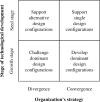A multi-level model of emerging technology: An empirical study of the evolution of biotechnology from 1976 to 2003
- PMID: 29795575
- PMCID: PMC5967744
- DOI: 10.1371/journal.pone.0197024
A multi-level model of emerging technology: An empirical study of the evolution of biotechnology from 1976 to 2003
Abstract
In this paper, we develop an ecological, multi-level model that can be used to study the evolution of emerging technology. More specifically, by defining technology as a system composed of a set of interacting components, we can build upon the argument of multi-level density dependence from organizational ecology to develop a distribution-independent model of technological evolution. This allows us to distinguish between different stages of component development, which provides more insight into the emergence of stable component configurations, or dominant designs. We validate our hypotheses in the biotechnology industry by using patent data from the USPTO from 1976 to 2003.
Conflict of interest statement
The authors have declared that no competing interests exist.
Figures
Similar articles
-
The Population Ecology of Technology: An Empirical Study of US Biotechnology Patents from 1976 to 2003.PLoS One. 2017 Jan 12;12(1):e0169961. doi: 10.1371/journal.pone.0169961. eCollection 2017. PLoS One. 2017. PMID: 28081570 Free PMC article.
-
Integrating models with data in ecology and palaeoecology: advances towards a model-data fusion approach.Ecol Lett. 2011 May;14(5):522-36. doi: 10.1111/j.1461-0248.2011.01603.x. Epub 2011 Mar 2. Ecol Lett. 2011. PMID: 21366814 Review.
-
European Union research and innovation perspectives on biotechnology.J Biotechnol. 2011 Dec 20;156(4):382-91. doi: 10.1016/j.jbiotec.2011.06.032. Epub 2011 Jul 1. J Biotechnol. 2011. PMID: 21745504
-
Microbial ecology pushes frontiers in biotechnology.Microbes Environ. 2014;29(1):1-3. doi: 10.1264/jsme2.me2901rh. Microbes Environ. 2014. PMID: 24694563 Free PMC article. No abstract available.
-
Traditional Chinese biotechnology.Adv Biochem Eng Biotechnol. 2010;122:189-233. doi: 10.1007/10_2008_36. Adv Biochem Eng Biotechnol. 2010. PMID: 19888561 Review.
References
-
- Schumpeter JA. Capitalism, Socialism and Democracy. London: George Allen and Unwin; 1943.
-
- Nelson RR, Winter SG. An evolutionary theory of economic change Cambridge: Harvard University Press; 1982.
-
- Murmann JP. The coevolution of industries and important features of their environments. Organ Sci. 2013; 24(1): 58–78.
-
- Krafft J, Quatraro F, Saviotti PP. Knowledge characteristics and the dynamics of technological alliances in pharmaceuticals: empirical evidence from Europe, US and Japan. J Evol Econ. 2014; 24(3): 587.
-
- Nikulainen T, Palmberg C. Transferring science-based technologies to industry—Does nanotechnology make a difference? Technovation. 2010; 30(1): 3–11.
MeSH terms
LinkOut - more resources
Full Text Sources
Other Literature Sources



